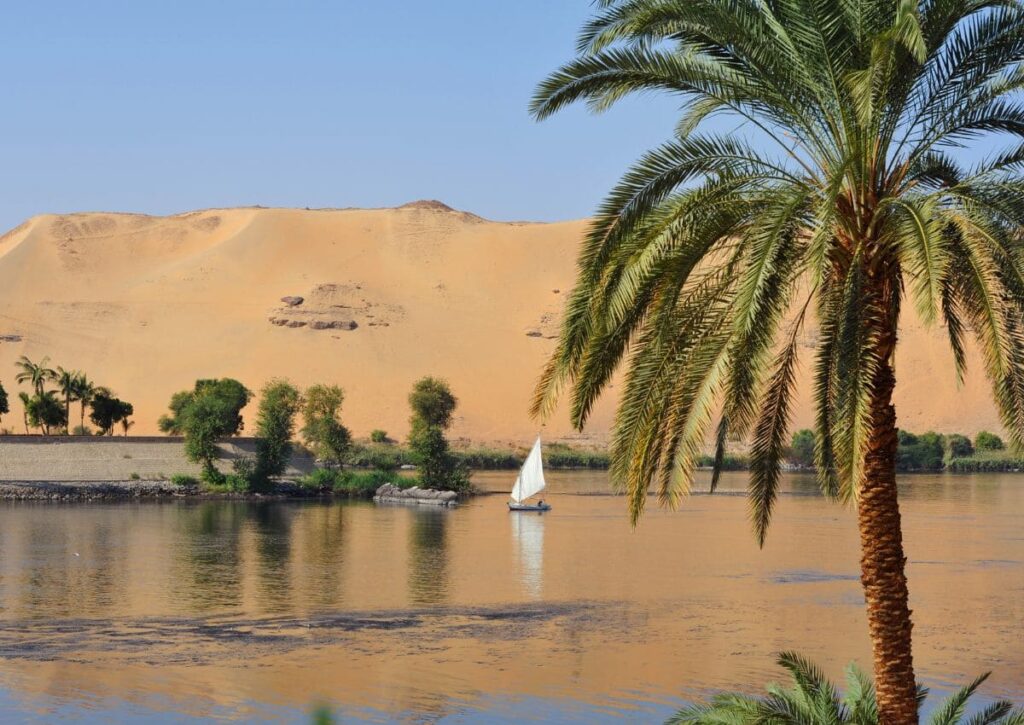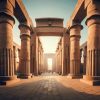A Local’s Expert Guide: Top Notch places to visit in Aswan
Aswan, a gem nestled along the sweeping curves of the Nile, is a city where time moves at its own gentle rhythm, inviting visitors to embrace a quieter, more contemplative way of life. Unlike the bustling streets of Cairo or the historic grandeur of Luxor, Aswan offers a tranquil retreat into the heart of Egyptian warmth and hospitality. Here, the kindness of its people shines as brightly as the sun-drenched landscapes, making every traveler feel welcomed and at ease.
The stunning Nile views in Aswan are unparalleled, with the river unfurling like a shimmering ribbon amidst golden sands and granite rocks. It’s a place where the simple act of watching the sunset can become a moment of profound beauty, as the sky and water merge into a palette of fiery hues. The Nile, lifeblood of Egypt, is at its most majestic here, bordered by lush banks and dotted with idyllic islands that beckon for exploration.
Among these islands, Elephantine and Kitchener’s Island stand out as jewels of natural and botanical wonder. Kitchener’s Island, in particular, is a haven of tranquility, home to the Aswan Botanical Garden. This garden is a living mosaic of plants from around the world, gathered during the colonial era and now thriving in the warm Egyptian climate. It’s a place where one can wander among rare and exotic plants, experiencing the diversity of the planet’s flora in a single, serene location.
The presence of such lush vegetation in the midst of a desert landscape is a testament to Aswan’s unique ecological and geographical position. It’s a city where the desert meets the river, creating environments of stark contrast yet surprising harmony. This juxtaposition is also reflected in the city’s pace of life—laid-back and leisurely, inviting visitors to slow down, relax, and soak in the beauty that surrounds them.
Aswan’s charm is not just in its landscapes and botanical wonders but in the daily life of its inhabitants. The people of Aswan are known for their warmth and generosity, characteristics that are deeply ingrained in their culture. Visitors are often struck by the genuine smiles and friendly greetings that meet them at every turn, making the city feel like a home away from home.
In Aswan, the allure of Egypt is presented not through monumental feats of architecture or the hustle and bustle of city life, but through the gentle flow of the Nile, the kindness of its people, and the quiet beauty of its natural surroundings. It’s a place that reminds us to appreciate the simpler pleasures of life, offering a peaceful escape into a world where time seems to stand still.
Explore the Romance Of Philae Temple
Nestled on the banks of the mighty Nile in Aswan, the gateway to the Temple of Isis begins with a simple, yet enchanting, embarkation. Travelers gather at a bustling port, where the hum of motorboats fills the air, each one ready to whisk visitors across the water to the sacred island of Agilkia. This journey is not just a mere transfer; it’s an unfolding narrative of rescue and preservation, thanks to UNESCO’s ambitious project that saved this gem from the engulfing waters caused by the construction of the High Dam. The relocation of the temple, originally on Philae Island, is a testament to global efforts in saving cultural heritage.
As your motorboat slices through the river, a sense of anticipation builds. The closer you get, the island seems to emerge as if by magic from the Nile’s azure embrace. This sensation is more than visual; it’s an emotional crescendo, evoking a profound connection to history and the divine. The Temple of Isis, dedicated to the goddess of wisdom, magic, and love, stands as a delicate marvel against the backdrop of Nile waters and blue skies. Its architecture, though monumental, carries an elegance that mirrors the grace of the deity to whom it is dedicated. It’s a place where the grandeur of ancient Egyptian civilization converges with the subtlety of feminine divinity, creating an atmosphere that’s both awe-inspiring and intimately tender.
Upon your return to the port, the experience is far from over. The lively energy of Nubian culture welcomes you back, as local vendors display their vibrant crafts, beaded accessories, and aromatic spices along the dockside. The air is filled with the melodious sounds of traditional Nubian music, inviting you to linger, explore, and engage. This is more than a marketplace; it’s a celebration of Nubian heritage, offering a glimpse into the daily life and spirit of the people who call this region home. Mingling with the locals, sharing smiles, and perhaps a dance or two, adds a rich layer of personal connection to your adventure.
The journey to and from the Temple of Isis is not just a tour; it’s a passage through time, a dance with divinity, and an embrace of vibrant culture. It leaves you with a profound appreciation for the past and a heart full of memories, carrying the essence of Egypt with you long after your departure.
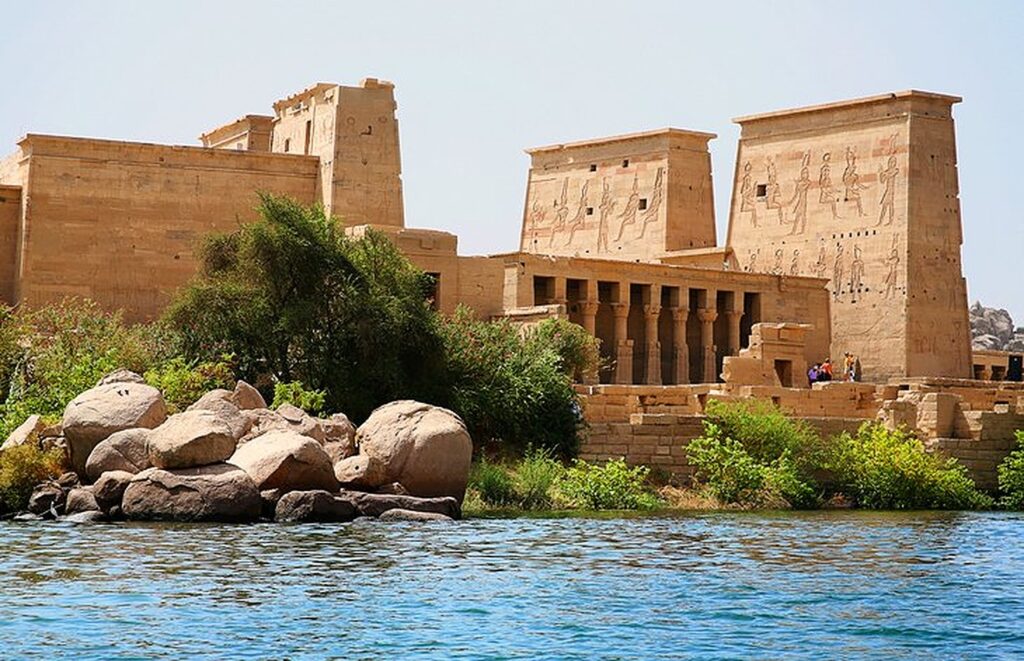
Marvel at the Light and Sound Show Temple at Philae
Now, if you thought I got carried away earlier, waxing lyrical about the majestic Temple of Isis during the sun’s high court, brace yourself. For I’m about to tread the same sacred ground again, this time under the cloak of night. And no, dear reader, your eyes do not deceive you, nor has my passion for Egyptology sent me into a delightful loop of repetition.
Picture this: the Temple of Isis, but not as we know it. Gone is the fierce sun, replaced by the velvet night sky, twinkling stars, and a stage set for an enchanting Sound and Light Show that could rival the grandeur of an opera in its own ancient way. As the first echoes of the show ripple through the air, it’s as if the temple awakens, ready to divulge its deepest secrets, ones only the cover of darkness can unveil.
This isn’t just another visit; it’s an entirely different experience. Imagine the silhouettes of the columns and the statues casting long shadows, as if stretching to whisper the tales of old directly into your heart. The show doesn’t just illuminate the temple; it breathes life into its stones, telling the story of Isis, Osiris, and their timeless love that defies even death itself. The waters of the Nile playfully reflect the myriad of lights, adding to the spectacle, making you feel as if you’re floating in a dream, adrift in time.
With every word spoken, every light cast, you’re not just watching a show; you’re participating in a ritual as old as the stories it tells. It’s an opera, yes, but one where the characters are gods and goddesses, and the stage is set by millennia of history. The atmosphere is charged with emotion, each beam of light and note of music designed to stir the soul, inviting you to listen, really listen, to the secrets Isis shares only with the night.
So, when I mention the Temple of Isis again, it’s not a slip of the pen but an invitation to see it in a new light—literally. For those who think they’ve seen all Aswan has to offer by day, the city’s nocturnal charm, especially around this ethereal temple, promises a spectacle that’s both visually and emotionally stirring, proving that some secrets are best shared under the cover of night.
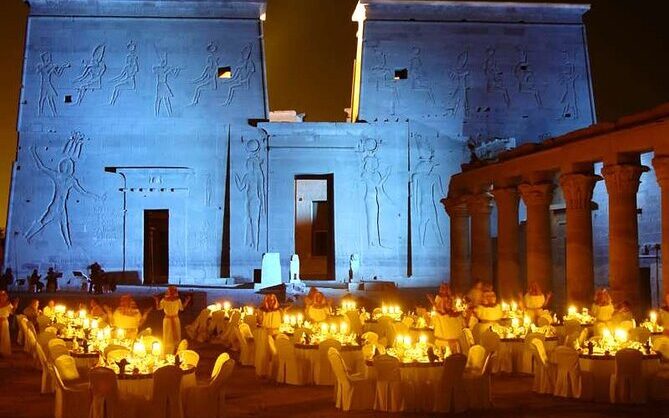
Understand the Impact of the Aswan High Dam
Writing about the High Dam in Aswan offers a compelling exploration into both the marvels and the complexities of human engineering and its socio-cultural impacts. When it was built in the 1960s, the Aswan High Dam was celebrated as a feat of modern engineering, a testament to human ingenuity and determination. The construction of the dam was an enormous undertaking, designed to control the annual flooding of the Nile, generate hydroelectric power, and provide water for agriculture. Its completion indeed transformed Egypt’s ability to manage its water resources, significantly boosting the country’s electricity supply and enabling the expansion of farmland through irrigation. For many in the northern parts of Egypt, the dam was a source of national pride and a symbol of progress, directly contributing to the quality of their daily lives by providing consistent electrical power to towns and cities, which was a significant development at the time.
However, the story of the High Dam is not without its darker shades, particularly when viewed from the perspective of the Nubian communities in the south. The creation of Lake Nasser, the vast reservoir formed by the dam, led to the displacement of over 50,000 Nubians from their ancestral lands along the banks of the Nile in Upper Egypt and Sudan. These communities were forced to relocate to new settlements in the Aswan region and further afield, tearing the fabric of their deeply rooted cultural and social lives. Promises of a return to their homelands were made, yet decades later, these promises remain unfulfilled, leaving a sense of betrayal and loss that lingers in the Nubian collective memory. The dam, therefore, represents an open wound for many Nubians, a symbol of the loss of their historical lands, culture, and heritage submerged under the waters of Lake Nasser.
The High Dam’s legacy is a dual narrative of triumph and tragedy, embodying the paradox of human progress. It stands as a monument to the power of human ambition and technological achievement, yet also as a reminder of the social and cultural costs that can accompany such endeavors. In writing about the High Dam, it’s important to navigate these contrasting narratives with sensitivity and awareness, acknowledging the dam’s role in Egypt’s development while also giving voice to the stories of those who paid its hidden costs. This approach not only honors the complexity of the High Dam’s impact but also reflects a more nuanced understanding of its place in Egypt’s modern history.
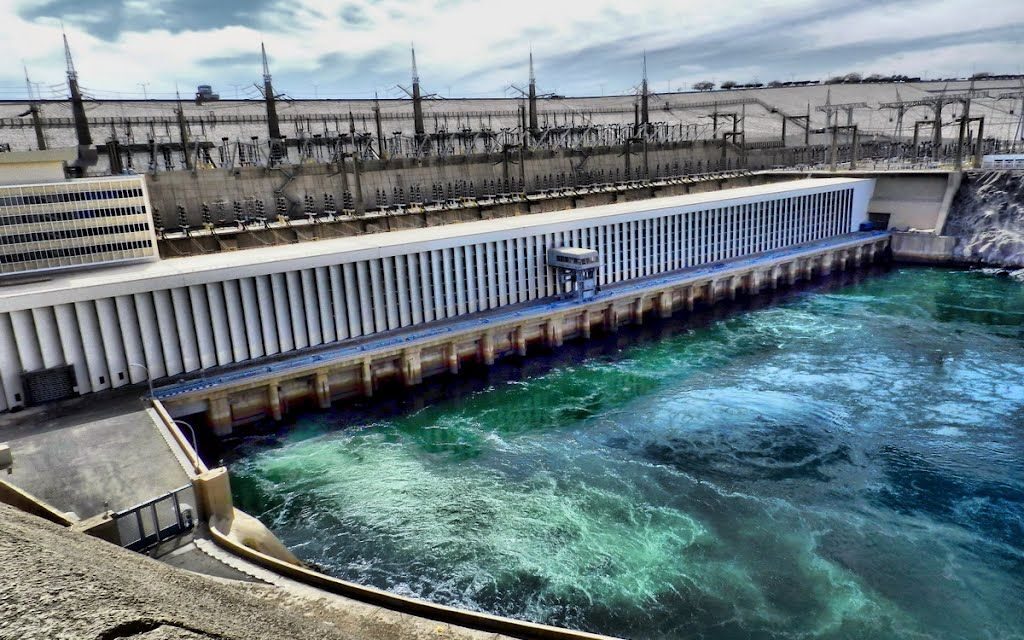
Ancient Explorations on Elephantine Island
Ah, Elephantine Island, a jewel of Aswan and a tapestry of ancient and living history, beautifully positioned on the Nile’s first cataract. This island is a treasure trove for those intrigued by Egypt’s deep history, culture, and the timeless rhythm of Nile river life. Let’s journey through the key highlights you’ve mentioned, immersing ourselves in the essence of this remarkable place.
Aswan Museum and the Ruins of Abu
At the southern tip of Elephantine Island, the Aswan Museum offers a gateway into the past, nestled amidst lush gardens. It’s like a time capsule, housing artifacts that narrate the island’s history from prehistoric times through the Roman era. Each artifact, whether a pottery shard or an intricate carving, tells a story of the civilizations that thrived here.
Adjacent to the museum lie the Ruins of Abu, Aswan’s most ancient settlement. This site is a mesmerizing glimpse into the distant past, where the Old Kingdom Temple of Khnum stands as a testament to the time when this deity was believed to control the Nile’s inundation, essential for the agriculture that sustained ancient Egypt. The Temple of Satet, dedicated to the goddess of the Nile’s floods, further enriches the site, offering insight into the religious devotion of the island’s ancient inhabitants.
Aswan’s Nilometer
The Nilometer on Elephantine Island is an ancient engineering marvel, meticulously designed to measure the Nile’s water levels. This tool was crucial for predicting the annual flood’s success, upon which the entire agrarian economy depended. Observing the Nilometer, you’re connected to the ancients’ hopes and anxieties, their dependence on the river’s ebb and flow, which dictated the prosperity or hardship of the year ahead.
The Villages of Koti and Siou
Beyond the historical monuments, the island is alive with the vibrant communities of Koti and Siou. Here, the heritage of Nile life unfolds in the colors of homes, the routines of daily life, and the enduring relationship with the land and river. The painted houses are a feast for the eyes, their designs a blend of tradition and personal expression. Walking through these villages, you encounter scenes that could have unfolded centuries ago: sheep grazing, chickens pecking in the alleyways, and farmers tending to their gardens with age-old techniques. It’s a living museum where the pulse of ancient Egypt beats in modern rhythms.
Elephantine Island is not just a place of ancient ruins and historical artifacts; it’s a living community where the past and present merge seamlessly. Visiting this island offers more than just a glimpse into Egypt’s grand history—it invites you into a world where that history is a backdrop to the daily lives of the people who call it home. The blend of cultural heritage, historical depth, and the vibrant life of its villages makes Elephantine Island a unique and unforgettable destination in Aswan.
Witness the Unfinished Obelisk’s Grandeur
The Unfinished Obelisk in Aswan is a marvel of ancient Egyptian engineering and ambition, a testament to the advanced skills and determination of its people. This monumental structure, found in the quarries of Aswan, is especially significant as it offers a rare, tangible insight into the stone-carving techniques used by the ancient Egyptians more than 3,000 years ago. Attributed to Queen Hatshepsut, one of Egypt’s most powerful female pharaohs who ruled during the 18th dynasty (around 1478-1458 BCE), this obelisk was never completed or erected. Yet, it speaks volumes about the architectural prowess and the cultural significance of such monuments in ancient Egypt.
Size and Reason for Abandonment
The Unfinished Obelisk is astounding in its dimensions. If completed, it would have stood approximately 42 meters (about 137 feet) tall and weighed nearly 1,200 tons. It would have been the largest obelisk ever erected in ancient Egypt. The project’s abandonment is believed to have been due to the discovery of cracks in the granite, which would have rendered the obelisk structurally unsound for transportation and erection. This massive structure, left lying on its side in the quarry, provides a unique snapshot of ancient Egyptian stone-working techniques.
Archaeological Importance
From an archaeological perspective, the Unfinished Obelisk is invaluable. It offers direct evidence of the methods used by ancient Egyptians to quarry such massive stone structures. The site shows clear marks of the tools and techniques used, such as dolerite balls to pound out the granite. It’s a rare, unaltered glimpse into the laborious process of obelisk construction, from its inception in the quarry to the final touches that were never applied.
Carving, Transporting, and Erecting Methods
The methods used to carve, transport, and erect these massive structures are a testament to the ingenuity of ancient Egyptians. Carving out an obelisk from solid granite required precise planning and a deep understanding of the material. Workers would first outline the shape of the obelisk on the rock face, then gradually detach it from the bedrock using a combination of pounding with dolerite balls and inserting wooden wedges into cracks, which were soaked with water to expand and split the stone.
Transporting these giants involved equally remarkable engineering feats. It’s believed that the Egyptians used sledges to move obelisks from the quarry to the Nile River, lubricating the sand with water to reduce friction. Once at the river, large barges were employed to float the obelisks to their destination, where they would be erected with great precision.
Although the Unfinished Obelisk was never erected, its presence offers a wealth of information about the ambition of ancient Egyptian rulers, the skill of their artisans, and the sophisticated techniques they developed. This monument stands as a silent witness to the architectural and cultural achievements of ancient Egypt, reflecting the greatness of a civilization capable of envisioning such monumental creations. The Unfinished Obelisk remains a focal point of archaeological study and a source of inspiration, inviting us to ponder the marvels of human ingenuity and perseverance.
Qubbet el-Hawa’s Ancient Secrets
Qubbet el-Hawa, known enchantingly as the “Dome of the Winds,” stands as a remarkable archaeological gem near Aswan, Egypt. Esteemed for its ancient tombs etched into the cliffs on the Nile’s west bank from the Old and Middle Kingdom eras, this site offers a window into the lives of the Elephantine Island’s rulers, or “nomarchs.”
The tombs at Qubbet el-Hawa are rich with inscriptions and autobiographical texts, serving as a key source for Egyptologists to unearth details about Egypt’s political, economic, and societal nuances during these historical periods. The site plays a crucial role in understanding the governance and interregional dynamics of ancient Egypt.
A story of particular interest involves the tomb of Sarenput II, a 12th Dynasty governor. Notable for its exquisite wall art and sculptures, this tomb also harbors a secret chamber, unveiled behind a wall, containing over 30 mummies of both genders and various ages. This discovery has illuminated aspects of burial traditions and family dynamics of that era.
Qubbet el-Hawa’s significance is amplified by its potential for new archaeological findings. Recent excavations, for instance, brought to light an untouched 6th Dynasty tomb, brimming with artifacts like pottery, wooden figures, and an intricately carved sarcophagus. These findings enrich our understanding of ancient Egyptian funerary customs and everyday life.
The narratives and ongoing investigations at Qubbet el-Hawa reveal the depth and complexity of its history, positioning it as an invaluable repository for those dedicated to unraveling the mysteries of ancient Egyptian culture. Its continuous study promises to further demystify the ancient civilization’s intriguing past.
Nubian History at the Museum
The Nubian history is a rich tapestry woven with the threads of ancient civilizations, powerful kingdoms, and unique cultural heritage that thrived along the banks of the Nile, south of what is now Aswan, Egypt, extending into present-day Sudan. This region, characterized by its vibrant traditions, languages, and artistic expressions, has been a crossroads of cultures for thousands of years. The Nubian people have played a crucial role in shaping the history of the Nile Valley, contributing significantly to the cultural and political landscape of ancient Egypt and beyond.
The Nubian Museum in Aswan stands as a testament to this enduring legacy. Opened in 1997, it was established to preserve and display the rich cultural heritage of Nubia, especially in light of the construction of the Aswan High Dam in the 1960s, which led to the flooding of much of the ancient land. The museum is not just a place to view artifacts; it’s an immersive journey into the heart of Nubia’s history and culture.
Travelers visiting the Nubian Museum can enjoy a comprehensive experience that spans the history of Nubia from prehistoric times to the present day. Here’s how to make the most of your visit:
- Prehistoric to Pharaonic Eras: Start your visit by exploring the early history of Nubia, including its Prehistoric, Pharaonic, and Roman periods. The museum houses over 3,000 artifacts that showcase Nubia’s role as a trade and cultural bridge between Africa and the Mediterranean world. Notable exhibits include magnificent statues, stelae, and a fascinating collection of pottery and jewelry that highlight the craftsmanship of the Nubian people.
- Christian and Islamic Nubia: As you proceed, you’ll encounter sections dedicated to the Christian and Islamic periods in Nubia, offering insights into the religious transformations that shaped the region. The exhibits include intricate frescoes, architectural elements from churches and mosques, and a variety of artifacts that reflect the religious diversity of Nubia through the ages.
- Modern Nubia: The museum also dedicates space to modern Nubian culture and the impact of the Aswan High Dam. It features models of submerged sites and displays on the massive UNESCO campaign to save Nubia’s monuments, including the famous relocation of the Abu Simbel temples. This section is a poignant reminder of the resilience of the Nubian people and their efforts to preserve their heritage.
- The Nubian Garden: Don’t miss the museum’s garden, which recreates a Nubian landscape with native plants and traditional Nubian architecture. It’s a peaceful spot to reflect on your visit and enjoy the beauty of Nubian culture in a natural setting.
- Interactive and Educational Programs: The museum often hosts workshops, cultural events, and temporary exhibitions that provide deeper insights into Nubian culture and history. Participating in these programs can enhance your understanding and appreciation of Nubia’s rich heritage.
For travelers looking to immerse themselves in the captivating history of Nubia, the Nubian Museum in Aswan offers a doorway into the past, presenting a narrative that is both enlightening and inspiring. It’s not just a museum; it’s an experience that connects visitors with the heart and soul of Nubia, encouraging a deeper appreciation for its enduring legacy and vibrant culture.
The Serene Aga Khan Mausoleum & Monastery of St. Simeon
Ah, the Aga Khan Mausoleum and the Monastery of St. Simeon, two jewels set against the backdrop of Aswan‘s breathtaking landscape, each telling a unique story of devotion, history, and beauty.
The Serene Aga Khan Mausoleum
Perched elegantly on the west bank of the Nile in Aswan, the Aga Khan Mausoleum is a sight of serene beauty and a testament to love and respect. It is the final resting place of Sir Sultan Muhammad Shah, Aga Khan III, the 48th Imam of the Nizari Ismailis, a Shia Muslim sect. Born in Karachi in 1877, the Aga Khan was a prominent figure, not just within his community for his spiritual leadership, but also on the global stage for his efforts towards social development and education.
What makes the mausoleum truly remarkable is its architectural beauty, which blends Islamic design with modern sensibilities. The structure, built from pink granite, stands majestically against the desert backdrop, its dome gleaming in the Egyptian sun. Inspired by the Fatimid architecture of Cairo, the mausoleum exudes a peaceful aura, inviting reflection and admiration. The Aga Khan was known to adore Aswan’s tranquil beauty and spent many winters here, which is why his wife, the Begum Aga Khan, chose this spot for his final resting place following his death in 1957.
Visitors, while unable to enter the mausoleum itself, can view its splendor from the outside, capturing the essence of peace that it embodies. The site overlooks the Nile, offering panoramic views that are simply breathtaking, especially at sunrise or sunset.
The Monastery of St. Simeon
The Monastery of St. Simeon, on the other hand, offers a glimpse into the early Christian period in Egypt. Dating back to the 7th century, this ancient monastery was once a thriving community of monks dedicated to St. Simeon. The monastery’s strategic location, overlooking the Nile from the west bank, served both as a spiritual retreat and a defensive position against invaders.
Today, the ruins of the monastery present a fascinating exploration for history buffs and travelers alike. Visitors can wander through the remnants of its imposing walls, living quarters, and the church, with its distinctive Nubian arches and columns. The site tells a story of devotion, isolation, and the harsh realities of desert monastic life. Despite the monastery’s eventual abandonment in the 13th century, the sense of peace and spiritual dedication lingers in the air, making it a profound visit for those seeking to connect with history.
Experiencing These Sites
While both sites differ vastly in their origins and the stories they tell, they share a common thread of serenity and historical significance. Visiting the Aga Khan Mausoleum and the Monastery of St. Simeon provides a unique insight into the rich tapestry of Egypt’s religious and cultural history.
When planning a visit, it’s worth noting that the journey to these sites can be as memorable as the destinations themselves. A felucca ride on the Nile to reach the west bank, where both sites are located, adds an element of adventure and authenticity to the experience.
Both the Aga Khan Mausoleum and the Monastery of St. Simeon remind us of the enduring nature of faith and the beauty that arises from devotion. They stand as serene witnesses to the passage of time, inviting travelers from around the world to pause, reflect, and marvel at the rich history of Egypt.
The Western Quarry (Gebal Simaan) Adventure
Exploring the Western Quarry, also known as Gebel Simaan or Gebel el-Silsila, near Aswan is like taking a step back into the ancient past, where the grandeur of Egyptian civilization carved its legacy into the very stone. This site, nestled along the banks of the Nile between Edfu and Kom Ombo, is an open-air museum testament to the ingenuity and artistry of the ancient Egyptians.
The Western Quarry was the source of much of the sandstone used in Egypt’s temples and monuments. The quarries stretch for kilometers and offer a fascinating insight into the practical and logistical aspects of ancient construction. Workers carved massive blocks of stone directly out of the mountain, which were then transported across the Nile and used in the construction of Egypt’s grand edifices, including the temples at Luxor and Karnak.
A visit to the Western Quarry isn’t just a journey into ancient industry but a voyage through history and nature. The remnants of ancient tool marks and inscriptions provide a direct link to the past, showcasing the evolution of quarrying techniques and the personal stories of the workers. Some inscriptions even record the water levels of the Nile, providing invaluable data on the climate and hydrology of ancient times.
Adventuring in this region offers more than just historical insights. The natural beauty surrounding the quarries, with the Nile flowing gently by and the desert stretching beyond, is breathtaking. The area is also a spot for modern-day adventurers and researchers who come to study its geology, history, and archaeology.
For those planning to visit:
- Timing: It’s best to visit early in the morning or late in the afternoon to avoid the midday heat.
- What to Bring: Ensure you have plenty of water, sunscreen, and comfortable walking shoes. The area is vast and open, so be prepared for a lot of walking under the sun.
- Guided Tours: Consider hiring a guide. A knowledgeable guide can enrich your experience, offering insights into the history and significance of what might otherwise look like mere rocks and inscriptions.
This adventure is not just about observing; it’s about immersing yourself in the ancient world, feeling the weight of history, and imagining the bustling activity of quarry workers millennia ago. The Western Quarry of Gebel el-Silsila is a testament to human endeavor, a place where the past is etched into the very stones that built a civilization.
New Kalabsha’s Lesser-Known Marvels
New Kalabsha is a treasure trove of ancient Egyptian architecture and culture that, despite its significance, often flies under the radar compared to more famous sites like the Great Pyramids or Luxor. Situated near Lake Nasser, it is especially notable for the Temple of Kalabsha, which was moved to its current location to save it from the rising waters of the Nile during the construction of the Aswan High Dam.
The Temple of Kalabsha is dedicated to Mandulis, a Nubian solar deity, and it is one of the largest free-standing temples in Nubia. Its relocation is part of the larger UNESCO Nubia Campaign, which sought to save and relocate numerous monuments threatened by the creation of Lake Nasser.
Beyond the Temple of Kalabsha, New Kalabsha houses other lesser-known marvels that are equally fascinating:
- Beit El-Wali: This rock-cut temple was moved from its original location near the Aswan High Dam. It was built during the reign of Ramesses II and is dedicated to the gods Amun and Ra-Horakhty. Its walls are adorned with vivid reliefs depicting Ramesses II’s military campaigns in Nubia, offering a glimpse into ancient Egyptian military history and relations with Nubia.
- Kiosk of Qertassi: Also known as Kiosk of Kertassi, this small but elegant structure is notable for its four slender columns with beautifully carved floral capitals. It is a charming example of Roman-era architecture, believed to have been built as a small chapel or gatehouse. Its relocation to New Kalabsha has preserved its delicate beauty for future generations to admire.
- The Gerf Hussein: Originally built to honor Ptah, the god of craftsmen and architects, parts of this temple were also moved to New Kalabsha. However, the main part was left in situ and is now submerged. The parts that were moved provide insight into the religious practices and architectural styles of the time.
- The Temple of Dendur: Though not at New Kalabsha, the Temple of Dendur is another monument relocated due to the Aswan High Dam project. It now resides in the Metropolitan Museum of Art in New York. It serves as a reminder of the global effort to save these irreplaceable monuments from destruction.
Exploring New Kalabsha offers a unique opportunity to delve into a less-traveled part of Egyptian history, where every stone tells a story of ancient gods, pharaohs, and the remarkable efforts of modern humanity to preserve its past. Whether you’re a history buff, a culture enthusiast, or just curious, the marvels of New Kalabsha await to tell you their timeless tales.
Conclusion
As we’ve journeyed through the heart of Aswan, exploring its serene landscapes, monumental achievements, and echoes of the past, it becomes clear that Aswan is not just a destination, but a passage to an enriching experience that speaks to the soul. From the tranquility of the Aga Khan Mausoleum to the ancient whispers of Elephantine Island and the marvels of modern engineering at the High Dam, each site invites you to delve deeper into the essence of this majestic city. But the adventure doesn’t end here. To truly embrace the spirit of Aswan, one must not only visit these timeless landmarks but also immerse in the unique activities that bring this city to life. I invite you, dear reader, to continue this exploration by diving into the companion piece that highlights the distinctive experiences Aswan offers, from the exhilarating camel treks across the desert to the indulgence of high tea at the Old Cataract Hotel. Together, these articles weave a tapestry of adventures that promise an unforgettable journey through Aswan’s rich heritage and breathtaking beauty.

Faris is the passionate founder of Travel2Egypt, deeply connected to Aswan’s essence. He aims to share the true heart of Egypt through its rich history, vibrant culture, and the warmth of its people. Join Faris to experience the magic of Aswan beyond the usual tourist paths.

